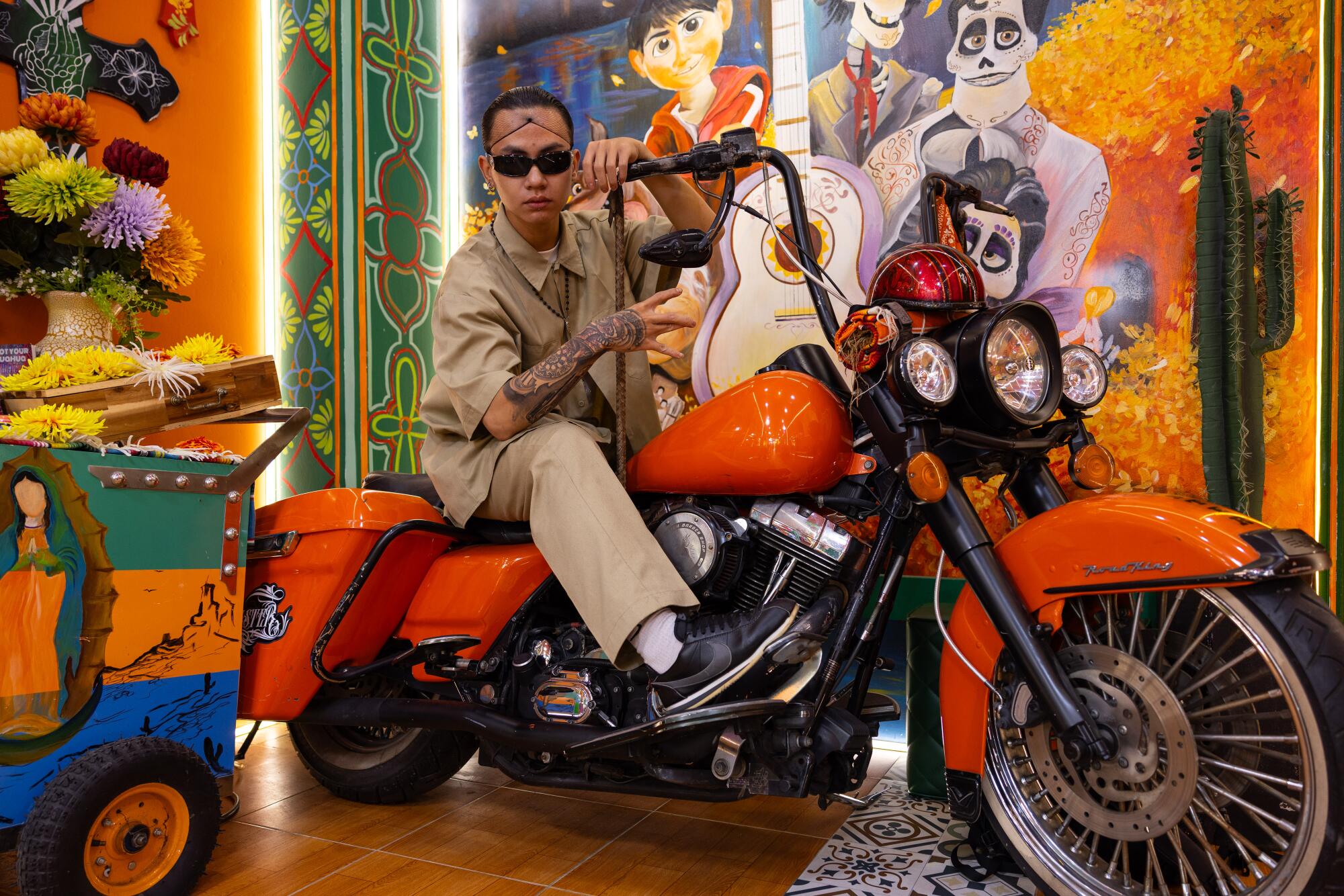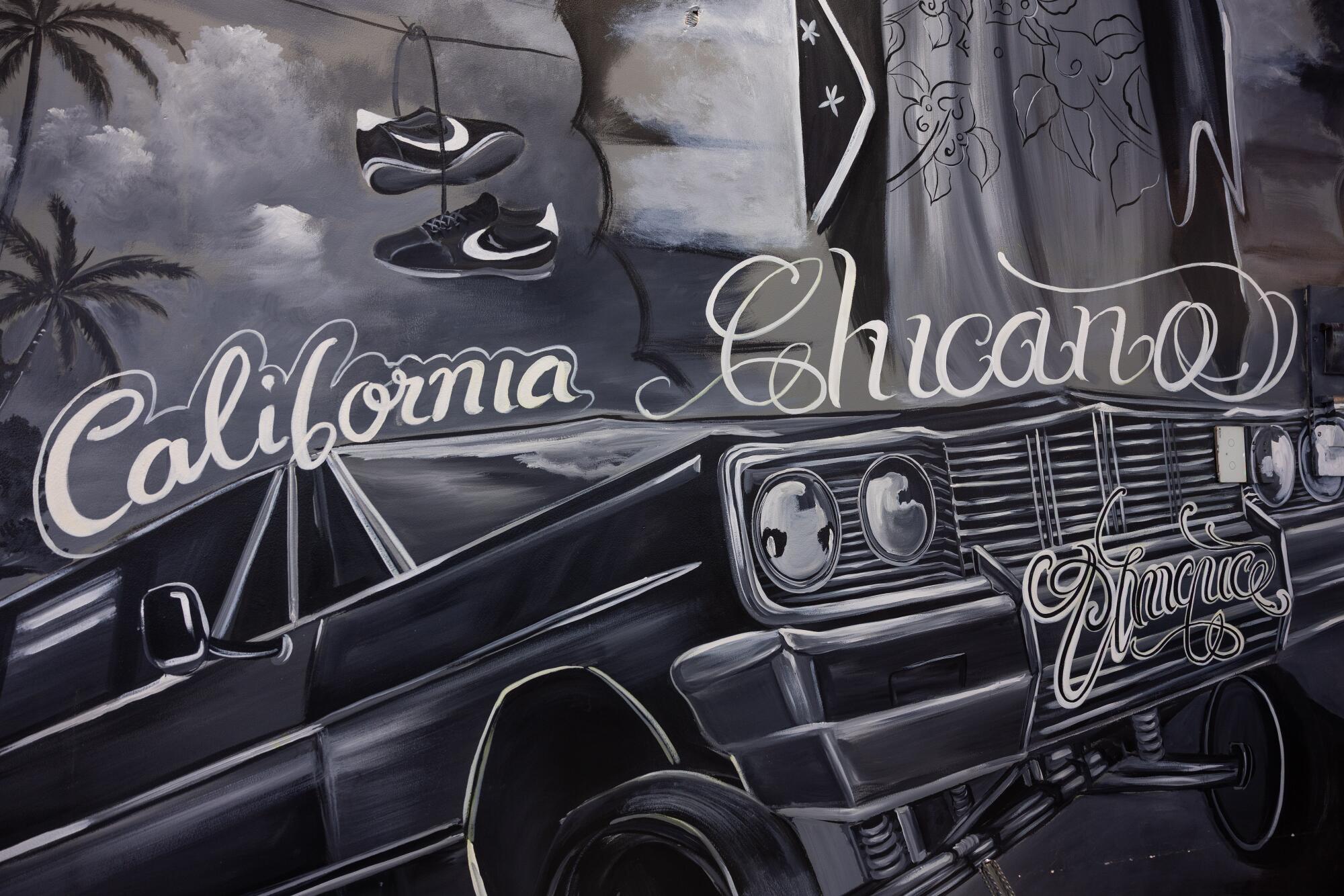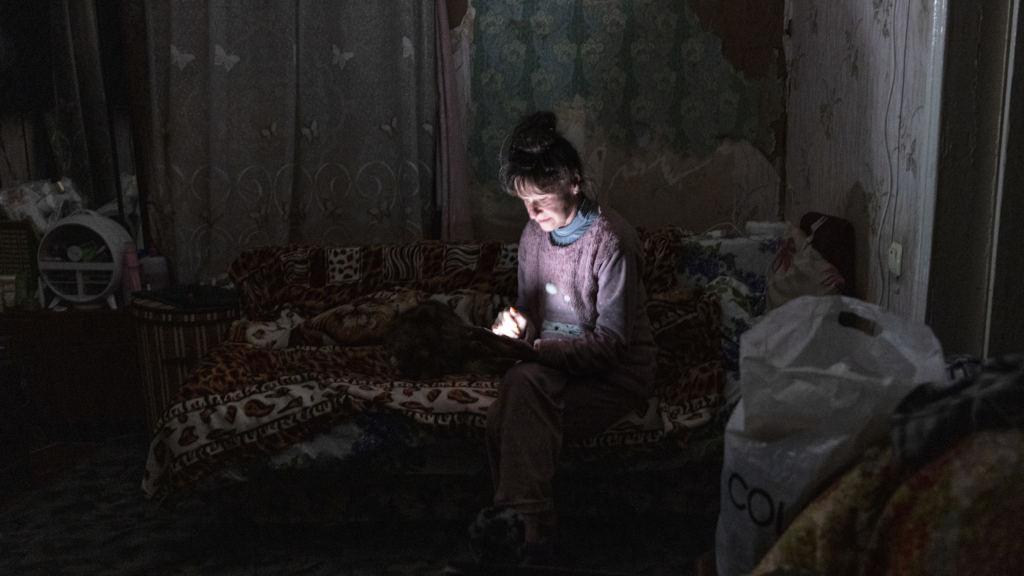HO CHI MINH CITY — When Nguyen Phuoc Loc first started dabbling in Chicano culture eight years ago, it was simply because he liked the way that the loose clothing offset his large head.
Today, he considers himself Chicano through and through. The 30-year-old Vietnamese barber has never been to the United States. Yet he has filled his life and work with tributes to Mexican American identity and culture.
The back of the barbershop he manages features a mural of the Virgen de Guadalupe, a cactus plant and a Mexican flag. Sneakers hang by their laces from barbed wire, dangling above two motorbikes.
Vietnamese barber Nguyen Phuoc Loc’s head is covered with tattoos. The left side is inked with the Spanish word for family — familia.
Even his shaved head is covered in the Gothic black letters long popular in Chicano culture that spell out: Family, Loyalty, L.A. The ink on his crown — a large number 6 — signifies his status as the sixth member of a small but increasingly visible community: a local band of barbers and tattoo artists who call themselves Viet Chicanos.
“In the beginning, I was just copying the older guys, their style and all,” said Loc, 30. “But over time, I started to feel that it really fit who I am. It happened gradually, like it seeped into me.”
Fashion aside, the culture has given Loc a sense of belonging, and motivation to work harder at his craft. He began watching movies steeped in Chicano culture, such as “American Me” and “Blood In Blood Out,” while using his limited English and translation apps to read about the movement online. He also started learning Spanish on Duolingo, but said that the language has been more difficult to pick up.
“If someone comes in from L.A., I’ll ask them everything I can about Chicano culture,” he said. “It’s like they’re tuned in to the exact frequency I’ve been on.”
Once a derogatory name for Mexican Americans, the term “Chicano” was reclaimed as a political identity during the 1960s, born out of their fight for civil rights in the American Southwest.
Since then, symbols of Chicano identity, such as oversized streetwear, elaborate tattoos and lowrider cars, have permeated mainstream culture. Subcultures influenced by Chicano imagery have cropped up in other parts of Asia, such as Thailand, the Philippines and most notably Japan, where a local love of lowriders emerged as early as the 1990s.

Armando Rendon, right, a member of the National Mexican-American Anti-Defamation Committee, holds a chart illustrating a key complaint — that Mexican Americans were dying in Vietnam “at a higher rate, highly disproportionate to their numbers in the total population of the United States” — at a news conference in Washington, D.C., in August 1970.
(Bettmann Archive)
Within conservative Asian cultures, the adventurous clothing and accessories of Chicano culture are a large part of the appeal, said Ignacio Lopez Calvo, a professor at UC Merced who has studied the spread of lowrider culture in Japan.
“It’s a way of defying traditional societal norms,” he said. “They see Chicano culture, this rebelliousness, resilience, independence, and it’s a way to express themselves, find an identity and create community.”
Berta Delgado Melgosa, a Spanish writer who has studied Chicano literature written by veterans of the Vietnam War, says Chicano soldiers there identified with certain parts of Vietnamese culture, while Chicano activists protested the racial inequality of the draft at home.
“When the Mexican American soldiers arrived in Vietnam, they saw people that resembled them: their facial features, their clothes, even their hats. They were poor, worked in the fields, and they also had a great sense of community, and more importantly, they were also fighting for their lives against U.S. imperialism,” she said.

Nguyen Phuoc Thien, who goes by Tea, poses on a motorbike at the Chicano-themed barbershop where he works in Ho Chi Minh City.
(Chris Trinh / For The Times)
Vietnam’s own Chicano “movement” began 10 years ago, when Nguyen Huynh Thanh Liem opened a barbershop dedicated to Chicano culture in Ho Chi Minh City. Now, the 38-year-old runs about 20 barbershops across the country, including three Chicano-style shops, and trains barbers such as Loc.
Tran Quoc Viet, a 37-year-old used car salesman, became a regular customer of Liem’s Barber Shop shortly after the first one opened in 2015. Back then, he was intrigued by the unusual aesthetic. While he never adopted the style of baggy clothing or tattoos, he was impressed with how the barbers pulled it off.
“At the time it could be called rebellious,” he said. “There was something bold and edgy about it, which made me curious.”

An apprentice at the Viet Monster Hood salon in Ho Chi Minh City inks a tattoo on a customer.
Many of the Vietnamese attracted to Chicano culture attribute their initial admiration to the bright colors and bold contrasts that Liem showcases in his signature shops.
The unconventional flair of the barbershops gives them a unique charm, and in the last few years, social media has helped the community boost its profile and gain a wider audience beyond Vietnam. Liem has more than 680,000 followers on TikTok, where he posts about Chicanos in Vietnam. Loc has 1.2 million TikTok followers; his most popular videos each have about 30 million views.
However, that attention hasn’t all been positive, particularly among older generations of Vietnamese, who are inclined to associate tattoos with gangs and violence.
“In Vietnam, when people see something new or unfamiliar, especially from another culture, they don’t always welcome it,” said Nguyen Van Thao, a 35-year-old tattoo artist who works at another one of Liem’s shops. “People often mock or even insult us on social media, saying things like, ‘You’re Vietnamese, why don’t you just be Vietnamese? Why do you have to be like that?’”
Thao began exploring Chicano-style tattoos with Liem when the two of them met 10 years ago. At that time, their frame of reference came mostly from online images. As they delved deeper into Chicano culture, Thao found that many other aspects resonated with him, such as the emphasis on family, resilience and respect.
“People often ask me why I chose this culture, but the truth is, I didn’t choose it. I discovered it, and it felt more like it chose me,” Thao said. “People come here, they hang out, they get inked, they support what we do. They helped me turn my life around.”
The stigma associated with tattoos and streetwear in Vietnam has played a role in keeping the core community small. While information about Chicano culture has increased, those who are steadfast enough to withstand the stares and learn about the underlying values are the ones who last, Thao said. He speculated that such social scrutiny puts undue pressure on women who have explored the Chicano community and decided not to stay.
“There are actually a lot of people who do like the culture — I know many who really do — but they’re hesitant,” he said. “They’re afraid of being stared at, judged, talked about, attacked. They can’t handle the criticism, so they give up.”

Tattoo artist Nguyen Van Thao poses for a portrait at Viet Monster Hood.
About 10 dedicated members of the community and their families often cycle in and out of Liem’s flagship salon, Viet Monster Hood, to work and socialize.
The Viet Chicanos are wary of attracting the wrong type of followers as well, who may be in pursuit of a different kind of lifestyle. Despite their fierce appearances, many of the barbers who work at Liem’s shops are soft-spoken and humble and reject any perceptions of violence and crime. They say they want to perpetuate cultural appreciation, rather than appropriation.
“We’re just inheriting this culture from a distance. And in doing so, we choose to carry on the beautiful parts,” Thao said. “We believe we can succeed this way, so that when people look at this culture, they see it connected to real success. And they see that the people who follow it are decent people, and we don’t have to be gangsters to be considered a true Chicano.”

Vietnam’s Chicano “movement” began 10 years ago, when Nguyen Huynh Thanh Liem opened a barbershop dedicated to Chicano culture in Ho Chi Minh City. Now, the 38-year-old runs about 20 barbershops across the country, including three Chicano-style shops.
When tattoo artist Michael Phan, 25, moved from Munich, Germany, to work for Thao two years ago, his only thought about Chicano culture was the superficial notion that it is associated with gangs. But his time at Viet Monster Hood changed that. Now, he likes to cite a quote from “Blood In Blood Out” that’s framed on the wall at the salon: “Chicano is not a color, but it’s the way you think and the way you live.”
“I love that, because it means you don’t have to be in America to embrace it,” he said.
Learning from Thao has helped Phan grow his social media following and his business, though his clients are still mostly foreigners. While he’s learned that Chicano and Vietnamese culture have a lot of similarities — such as prioritizing family — he believes that Vietnamese, including his relatives, may take longer to come around.
For 60-year-old Nguyen Thi Bich, who was taught that people with tattoos are dangerous, stepping foot in Viet Monster Hood was intimidating at first. However, she relaxed after seeing how cheerful the barbers were when teasing her 7-year-old grandson.
“When we went to other barbershops where people were grumpy, my little grandson got scared and didn’t want to go back,” she said. “Now I have been around people with tattoos, getting to know them, I realized there are all kinds of people everywhere.”
While she’s still unfamiliar with what Chicano means, she’s grown fond of the environment at Viet Monster Hood, where decals that say “Vietnamese Gang,” are everywhere, hip-hop blares in the background and even the shop bulldog, Simba, has drawn-on tattoos.
“This shop feels like one of those places where young people go to rap,” she said. “I’ve been watching rap on TV lately, and I quite enjoy it.”
